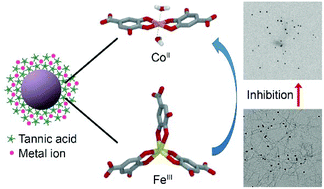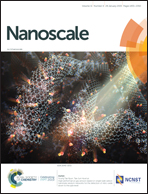Metal-dependent inhibition of amyloid fibril formation: synergistic effects of cobalt–tannic acid networks†
Abstract
Metal–phenolic networks (MPNs) have received widespread interest owing to their modular incorporation of functional metal ions and phenolic ligands. However, the interaction between MPNs and biomolecules is still relatively unexplored. Herein, we studied the effects of MPN-coated gold nanoparticles on amyloid fibril formation (which is associated with Alzheimer's disease) as a function of the metal ion in the MPN systems. All coated particles examined inhibited amyloid formation, with cobalt(II) MPN-coated particles exhibiting the highest inhibition activity (90%). Molecular dynamics simulations and quantum mechanics calculations suggested that the geometry of the exposed cobalt coordination site in the cobalt–tannic acid networks facilitates its interactions with histidine and methionine residues in the amyloid beta peptides. Furthermore, the unique structure of cobalt MPNs may enable a wider variety of biomedical applications.

- This article is part of the themed collection: Advisory Board research selection


 Please wait while we load your content...
Please wait while we load your content...